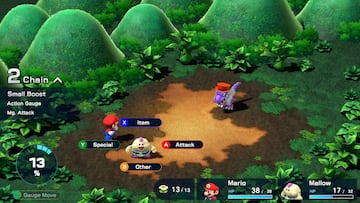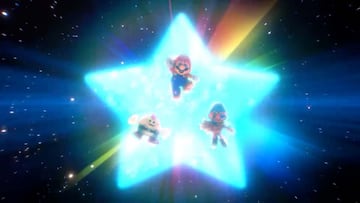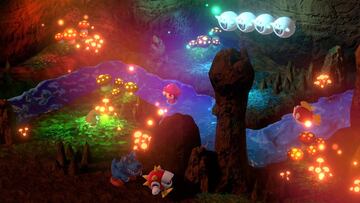Nintendo
Super Mario RPG: Preserving a classic
27 years after its release, Super Mario RPG returns to Nintendo Switch with revamped graphics that prove that what’s done well can last.
The idea of Nintendo lending one of its most important characters to another company to make another game sounded unthinkable... in 1996. Super Mario RPG: The Legend of the Seven Stars was one of the last titles to hit the legendary Super Nintendo, and it impressed by combining the great RPG skills of Square with the world created by Shigeru Miyamoto in a title that combined the best of both worlds.
The game has been one of the company’s greatest successes, which over the years has not been forgotten on the shelves of history and has managed to have a presence in the Virtual Console, as well as in the SNES Classic catalog. However, 27 years later, we have the return of this important title with a graphical improvement and certain adjustments so that a whole new generation can get to know it on Nintendo Switch and those of us who played the original version can rediscover it.
The Mushroom Kingdom from a New Perspective
As the name suggests, Super Mario RPG is a role-playing game where instead of taking the place of some soldier or disgraced prince in a high fantasy world, as is almost always the case, we are transported to the Mushroom Kingdom of the Super Mario games. The story begins when Princess Peach is kidnapped (“Again?!” some members of the kingdom’s court would say) and it’s Mario’s turn to rescue her in Bowser’s castle. However, the status quo changes when a giant sword called Exor falls from the sky and plunges into the King of the Koopa’s castle, sending our plumber flying. Thus begins the adventure in which we will discover new places and characters in the areas surrounding the Mushroom Kingdom, with a story that, although not deep, has the twists and tropes worthy of the genre, as we go searching for the 7 Stars of Star Road throughout this world. Throughout the game we go through this world with characters that exude charisma, with small stories and details.

Building on the original
This title is more of a graphical remake than a gameplay remake, as the story is practically the same as it was on the Super Nintendo, and the mechanics, although they have been tweaked a bit, are still very similar to the RPGs of the time. The game allows you to play not only with Mario (who we always use), but also with familiar characters like Bowser and Peach, as well as new ones like Mallow and Geno. Each one represents a certain archetype, and like a good RPG, they level up, increase their stats, and can be equipped with weapons, clothes, and accessories to make them stronger.
One of the main improvements the game has received is in combat. Although this part of the RPG retains its essence of being turn-based, with the use of normal attacks, special moves, and items, there have been some adjustments to make this part more interactive. This time, the timing of button presses will be part of the game’s strategy, as when we launch or receive an enemy attack, pressing the action button at the right time will cause us to do more damage or reduce the damage we receive. Although there are some enemy attacks that we can’t dodge (such as some special attacks or those that affect our stats), the vast majority of confrontations involve paying attention to this extra. If you’ve played the Mario & Luigi series or Paper Mario, the RPGs after the original, you’ll have an idea of how this works.

In addition to attacks and defenses, some of our characters’ special powers require additional interaction by pressing the A Button at the right moment. On the other hand, other moves, such as throwing fireballs with Mario, require you to press the A Button several times to fill up a bar, and when it fills up, the last attack will be even more powerful.
Going back to timing, this adds two very important factors to combat. Firstly, there is a counter that adds up the number of consecutive times you have attacked (and defended) at the exact moment. As this number increases, the power of Mario and his friends increases, so the hits you land on an enemy can have an effect on those around them. Although it would be easy to chain these attacks and defenses together, the same attack pattern from enemies can be the main reason for not reaching such a high number in the long run. On the other hand, there is a meter at the bottom left that fills up with every attack we hit. When it fills up, two things will happen: If there are only two characters on your team, Toad will offer you a random item that will help you in battle. Later in the game, however, you will be able to perform a special attack between the three characters you control at that moment. It is a devastating attack that, in 90′s RPG terms, is akin to the combo attacks of Chrono Trigger and Final Fantasy VII’s Limit Break.

Finally, combat adds a final element: special enemies. These will have a legend next to their name. These enemies will have greater resistance and attack, making them more difficult to defeat, but they will also offer greater rewards to the player.
More beautiful than the last time we met
The visual aspect is where the game differs the most from the original. And of course this is a more than obvious comment considering that only 4 console generations have passed. But this is the great detail that preserves a game so that more generations can play it. The scenarios, both cities, towns, streets and dungeons, although small in size, are full of detail, highlighting many of the elements that may not have looked as good in the SNES version due to the limitations of the console at the time. There are also a number of completely new cutscenes that, although not many, add a new perspective to the game.
We must also mention its music. The music of Super Mario RPG is one that you will surely remember if you played it back in the day. This version has two versions, both the music as we heard it on the SNES, so the most nostalgic can play it that way, or a completely new version that gives more life to what we knew. Both options are good and fill the worlds we go through with energy.

Super Mario RPG is a great tribute to the original game, transporting an experience more than 25 years old with graphics more in line with the times, without losing the essence of what the SNES title once was. The tweaks and additions are spot on, keeping everything in place and adding an extra challenge that doesn’t get in the way of the experience. If you have already played Super Mario RPG, or if you have never had the experience of playing this game, this is your chance to experience one of the great collaborations in the world of video games.